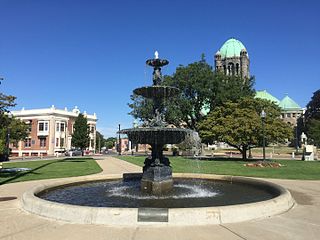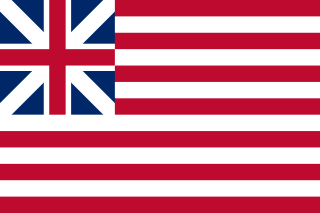
The American Revolution was a rebellion and political revolution in the Thirteen Colonies, which saw colonists initiate a war for independence against the Kingdom of Great Britain. Colonial separatist leaders who had originally sought more autonomy within the British political system as British subjects, assembled to establish a new national government following the recognition of their independence which resulted in the creation of the United States of America.

A flag is a piece of fabric with a distinctive design and colours. It is used as a symbol, a signalling device, or for decoration. The term flag is also used to refer to the graphic design employed, and flags have evolved into a general tool for rudimentary signalling and identification, especially in environments where communication is challenging. Many flags fall into groups of similar designs called flag families. The study of flags is known as "vexillology" from the Latin vexillum, meaning "flag" or "banner".

The Union Jack, or Union Flag, is the de facto national flag of the United Kingdom. The Union Flag was also used as the official flag of several British colonies and dominions before they adopted their own national flags. The flag continues to have official status in Canada, by parliamentary resolution, where it is known as the Royal Union Flag.

The national flag of Sweden consists of a yellow or gold Nordic cross on a field of light blue. The Nordic cross design traditionally represents Christianity. The design and colours of the Swedish flag are believed to have been inspired by the present coat of arms of Sweden of 1442, which is blue divided quarterly by a cross pattée of gold. Blue and yellow have been used as Swedish colours at least since Magnus III's royal coat of arms of 1275.

Taunton is a city in Bristol County, Massachusetts, United States. It is the seat of Bristol County. Taunton is situated on the Taunton River which winds its way through the city on its way to Mount Hope Bay, 10 miles (16 km) to the south. At the 2020 census, the city had a population of 59,408. Shaunna O'Connell is the mayor of Taunton.

The Red Ensign or "Red Duster" is the civil ensign of the United Kingdom of Great Britain and Northern Ireland. It is one of the British ensigns, and it is used either plain or defaced with either a badge or a charge, mostly in the right half.

Robert Treat Paine was a lawyer, politician and Founding Father of the United States who signed the Continental Association and Declaration of Independence as a representative of Massachusetts. He served as the state's first attorney general and as an associate justice of the Massachusetts Supreme Judicial Court, the state's highest court.

The Sons of Liberty was a loosely organized, clandestine, sometimes violent, political organization active in the Thirteen American Colonies founded to advance the rights of the colonists and to fight taxation by the British government. It played a major role in most colonies in battling the Stamp Act in 1765 and throughout the entire period of the American Revolution.

The Battle of Kings Mountain was a military engagement between Patriot and Loyalist militias in South Carolina during the Southern Campaign of the American Revolutionary War, resulting in a decisive victory for the Patriots. The battle took place on October 7, 1780, 9 miles (14 km) south of the present-day town of Kings Mountain, North Carolina. In what is now rural Cherokee County, South Carolina, the Patriot militia defeated the Loyalist militia commanded by British Major Patrick Ferguson of the 71st Foot. The battle has been described as "the war's largest all-American fight".

The flag of Great Britain, commonly known as King's Colours, the first Union Flag, the Union Jack, or the British flag, was used at sea from 1606 and more generally from 1707 to 1801. It was the first flag of the Kingdom of Great Britain. It is the precursor to the Union Jack of 1801.

Loyalists were colonists in the Thirteen Colonies who remained loyal to the British Crown during the American Revolutionary War, often referred to as Tories, Royalists or King's Men at the time. They were opposed by the Patriots, who supported the revolution, and called them "persons inimical to the liberties of America."

Patriots, also known as Revolutionaries, Continentals, Rebels, or Whigs, were colonists in the Thirteen Colonies who opposed the Kingdom of Great Britain's control and governance during the colonial era, and supported and helped launch the American Revolution that ultimately established American independence. Patriot politicians led colonial opposition to British policies regarding the American colonies, eventually building support for the adoption of the Declaration of Independence, which was adopted unanimously by the Second Continental Congress on July 4, 1776. After the American Revolutionary War began the year before, in 1775, many Patriots assimilated into the Continental Army, which was commanded by George Washington and which secured victory against the British, leading the British to acknowledge the sovereign independence of the colonies, reflected in the Treaty of Paris, which led to the establishment of the United States in 1783.

The "Grand Union Flag", or the "Continental Colors", also known as the "Congress Flag", the "Cambridge Flag", and the "First Navy Ensign", was the first, unofficial national flag of the United States of America. First hoisted on December 3, 1775 by naval officer John Paul Jones, the flag was used heavily by the Second Continental Congress of the United States, and by George Washington, commander-in-chief of the Continental Army during the American Revolutionary War.

The Liberty Tree (1646–1775) was a famous elm tree that stood in Boston, Massachusetts near Boston Common in the years before the American Revolution. In 1765, Patriots in Boston staged the first act of defiance against the British government at the tree. The tree became a rallying point for the growing resistance to the rule of Britain over the American colonies, and the ground surrounding it became known as Liberty Hall. The Liberty Tree was felled in August 1775 by Loyalists led by Nathaniel Coffin Jr. or by Job Williams.

The Taunton Green Historic District encompasses the core area of the historic 19th-century commercial downtown business district of Taunton, Massachusetts. It is centered on the town green, laid out in the 1740s, which now serves at the intersection between U.S. Route 44, Massachusetts Route 140, and Route 138. The district was listed on the National Register of Historic Places in 1985.
Prudence "Pru" Cummings Wright was a militia commander during the American Revolutionary War.

The George Rex Flag was a protest flag used in the Province of New York at the start of the American Revolutionary War. The flag was adopted following the passage of the Quebec Act 1774 whereby French Canadian Roman Catholics were granted emancipation and Roman Catholicism was adopted as the state church of the Province of Quebec. Though it is not known exactly what the design of the flag was, the commonly accepted version consisted of either an altered Red Ensign or Blue Ensign with the words "George III Rex and the Defender of the Liberties of America. No Popery".

Tory Act of 1776 was penned as seven resolutions passed by the Second Continental Congress in Philadelphia, Pennsylvania on January 2, 1776. The legislative resolutions emphasized the American Patriots opposing sentiments towards the colonial political factions, better known as British America's Tories or Royalists.
Richard Draper (1726–1774) was an early American Boston printer and an editor of The Boston News-Letter. Together with his father and his nephew Draper printed and published The News-Letter. In the years leading up to the American Revolution Draper sided with the Loyalists and the Tory party, and through his newspaper he provided a voice for the Loyalist writers in Massachusetts and elsewhere.


















